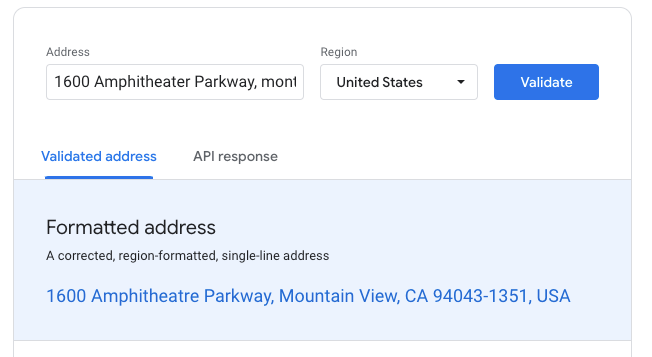مقدمه
Address Validation API سرویسی است که یک آدرس را می پذیرد. اجزای آدرس را شناسایی و آنها را تأیید می کند. همچنین آدرس پستی را استاندارد می کند و بهترین مختصات طول و عرض جغرافیایی شناخته شده را برای آن پیدا می کند. به صورت اختیاری، برای آدرسهای ایالات متحده و پورتوریکو، میتوانید سیستم پشتیبانی دقت کدگذاری (CASS™) را فعال کنید.چرا از Address Validation API استفاده کنید
با استفاده از Address Validation API، میتوانید پیشبینیپذیری تحویل را بهبود ببخشید و خرابیهای تحویل را کاهش دهید، در نتیجه تجربه بهتری برای مشتری فراهم کنید. شما این کار را با گرفتن آدرس های بد و به دست آوردن آگاهی بهتر از ویژگی های آدرس انجام می دهید.
اگر نیازی به تأیید اعتبار اجزای جداگانه آدرس ندارید، API Geocoding ممکن است با نیازهای شما مطابقت بیشتری داشته باشد. Geocoding API آدرس ها را به مختصات طول و عرض جغرافیایی تبدیل می کند . Address Validation API آدرس ها را برای صحت اعتبارسنجی می کند. برای مقایسه دقیق، قابلیت اعتبارسنجی مکان ساختمان با استفاده از پلتفرم نقشه های گوگل را در مرکز معماری ببینید.
کارهایی که می توانید با Address Validation API انجام دهید
با Address Validation API، می توانید تعیین کنید که آیا یک آدرس به یک مکان واقعی اشاره دارد یا خیر. اگر آدرس به یک مکان واقعی اشاره نمی کند، API می تواند اجزای احتمالاً اشتباهی را شناسایی کند که می توانید برای اصلاح آنها به مشتریان خود ارائه دهید. در اینجا یک نمونه گردش کار با استفاده از API آمده است:
مشتری یک آدرس را وارد می کند - تصویر زیر یک فرم اصلی را نشان می دهد که به مشتری امکان می دهد آدرس را وارد کند، احتمالاً به عنوان بخشی از جریان پرداخت.
برنامه آدرس را به API ارسال می کند - برنامه این آدرس را به عنوان ورودی به Address Validation API ارسال می کند.
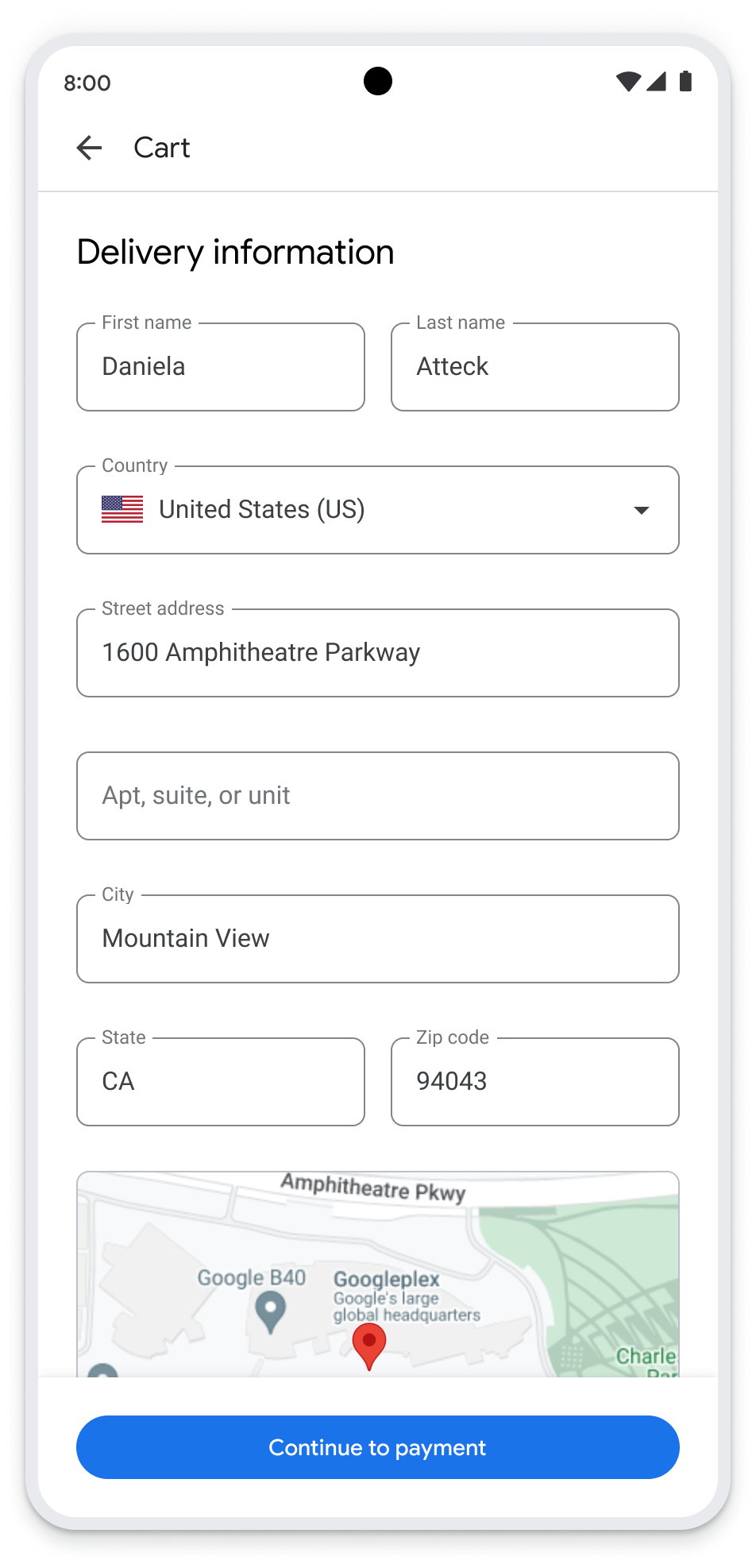
API آدرس را اعتبار سنجی و استاندارد می کند - در پاسخ، Address Validation API آدرس کاملی را که توسط API تعیین شده برمی گرداند، یا نشان می دهد که کجا اطلاعات گم شده است.
مشتری آدرس را تأیید یا تصحیح می کند - بسته به آنچه API برمی گرداند، می توانید اعلان های زیر را به مشتری ارائه دهید: الف. آدرس توصیه شده را تأیید کنید. ب- اطلاعات گمشده را ارائه دهید. ج. آدرس را درست کنید.
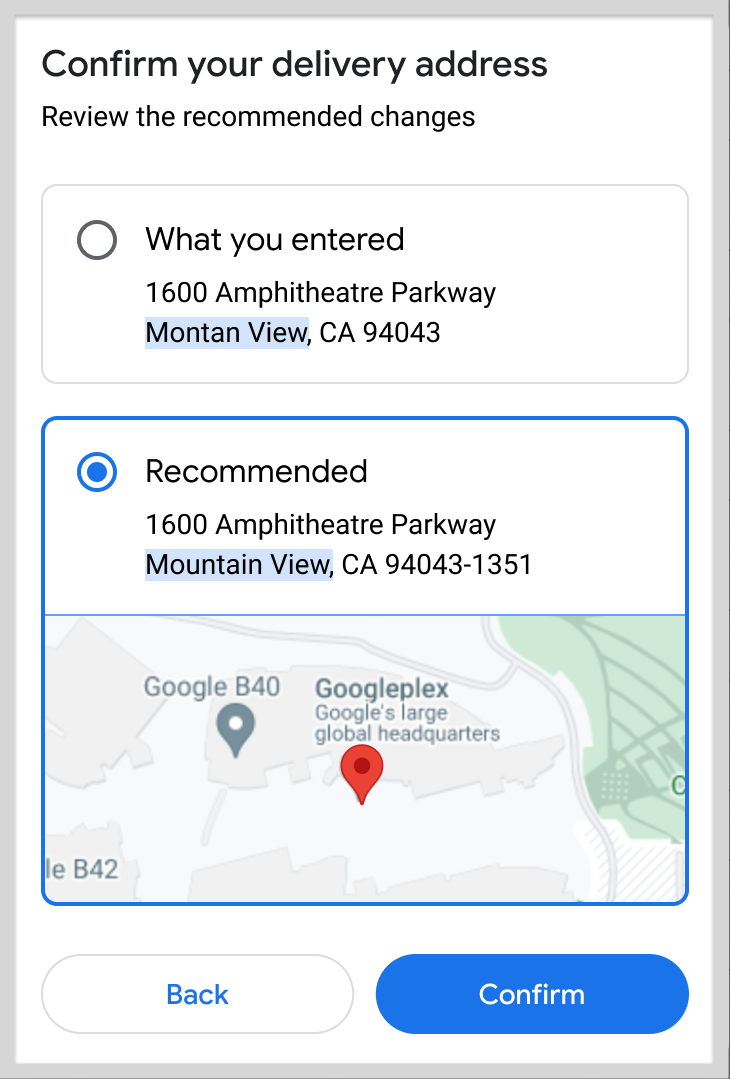
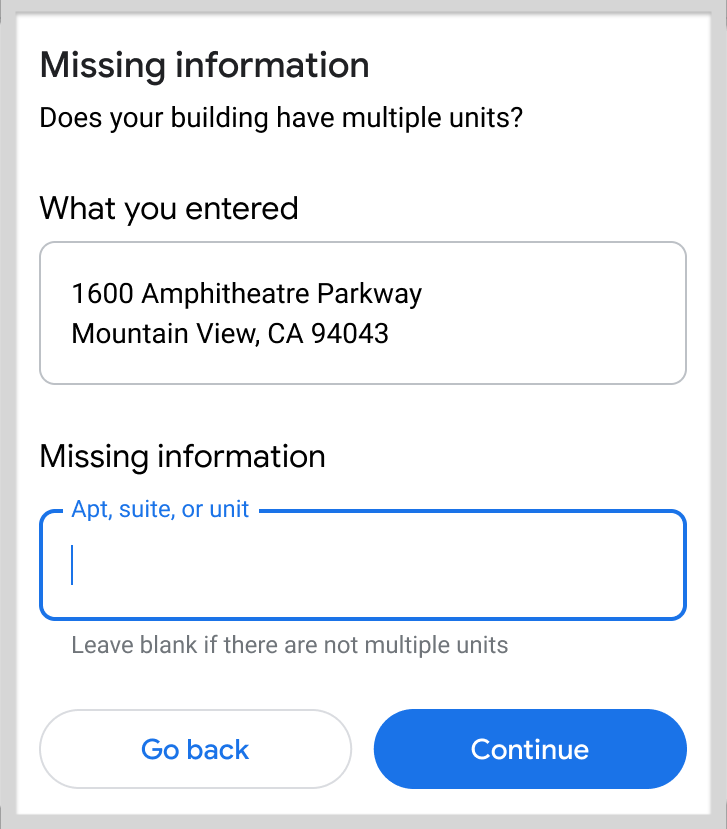
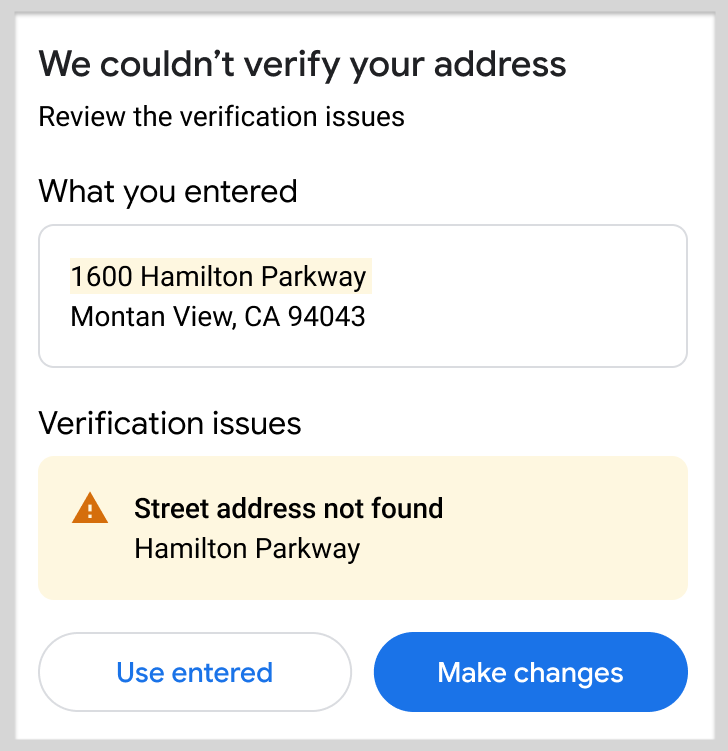
نحوه عملکرد Address Validation API
اعتبار آدرس یک درخواست POST را با آدرس در قالب یک بدنه JSON می پذیرد. آدرس را به اجزای جداگانه آن جدا می کند و سپس موارد زیر را انجام می دهد:
- تصحیح می کند — بررسی های تأیید اعتبار در سطح مؤلفه، از جمله مکان های فرعی در صورت وجود را ارائه می دهد.
- تکمیل - تلاش برای استنباط اجزای آدرس گم شده یا نادرست.
- قالبها - قالب را برای اجزای آدرس تمیز و استاندارد میکند.
منابع
جدول زیر منابع موجود از طریق Address Validation API را به همراه داده هایی که برمی گرداند خلاصه می کند. برای جزئیات خاص، به مرجع Address Validation API مراجعه کنید.
| منابع داده | داده ها برگردانده شد |
|---|---|
اجزای آدرس در قالب JSON. به تأیید یک آدرس مراجعه کنید. | آدرس کامل و معتبر (در صورت امکان). وضعیت اعتبارسنجی هر جزء آدرس. جایی که برای یک آدرس موجود است:
به درک پاسخ اعتبارسنجی مراجعه کنید. |
نحوه استفاده از Address Validation API
| 1 | نسخه ی نمایشی را امتحان کنید | نسخه ی نمایشی را با انواع فرم های آدرس، درست و نادرست، کاوش کنید . نسخه ی نمایشی یک راه مفید برای بررسی مقادیر بازگشتی از سرویس و همچنین پاسخ API فرمت شده JSON ارائه می دهد. |
| 2 | پوشش را بررسی کنید | جزئیات پوشش را مرور کنید تا ببینید Address Validation API از کدام کشورها و مناطق پشتیبانی می کند. |
| 3 | راه اندازی شود | با راه اندازی پروژه Google Cloud خود شروع کنید و دستورالعمل های زیر را تکمیل کنید. |
| 4 | درخواست اعتبار سنجی آدرس | با یک آدرس اولیه شروع کنید و سپس، برای دقت بیشتر، می توانید CASS را فعال کنید (فقط برای آدرس های ایالات متحده و روابط عمومی). به درخواست اعتبار سنجی آدرس مراجعه کنید. |
| 5 | یک پاسخ را پردازش کنید | پاسخ Address Validation API دو ویژگی را ارائه می دهد که از هر کدام به روش های مختلف استفاده می کنید. به درک پاسخ اولیه مراجعه کنید. |
| 6 | بهبود دقت اعتبارسنجی | میتوانید با ارائه بازخورد درباره پاسخهای Address Validation API به بهبود دقت آدرس کمک کنید. به آدرس های به روز شده رسیدگی کنید . |
کتابخانه های مشتری موجود
برای فهرستی از کتابخانه های سرویس گیرنده موجود برای Address Validation API، به کتابخانه های سرویس گیرنده مراجعه کنید.
درباره CASS™
خدمات پستی ایالات متحده® (USPS®) 1 سیستم پشتیبانی دقت کدگذاری (CASS™) را برای پشتیبانی و تأیید ارائه دهندگان اعتبارسنجی آدرس حفظ می کند. یک سرویس CASS Certified™، مانند Address Validation API، به دلیل توانایی آن در پر کردن اطلاعات گم شده از یک آدرس، استاندارد کردن آن و به روز رسانی آن برای ارائه جدیدترین و دقیق ترین آدرس تأیید شده است.
CASS به طور پیش فرض فعال نیست و فقط برای مناطق "US" و "PR" پشتیبانی می شود. برای فعال کردن CASS، enableUspsCass به عنوان بخشی از درخواست اعتبارسنجی روی true تنظیم کنید. برای اطلاعات بیشتر، به تأیید اعتبار آدرس مراجعه کنید.
به عنوان بخشی از استفاده ما از خدمات USPS، USPS درخواستها را برای آدرسهای ایجاد شده مصنوعی ارزیابی میکند. اگر USPS تشخیص دهد که یک آدرس ورودی بهطور مصنوعی ایجاد شده است، Google موظف است اعتبار آدرسها را برای مشتری متوقف کند و باید اطلاعات تماس مشتری (نام و آدرس)، آدرس ورودی مربوطه، و دادههای استفاده جمعآوری شده را به USPS گزارش دهد. با استفاده از API با این شرایط خاص سرویس موافقت می کنید.
بعدش چی
- نسخه ی نمایشی را امتحان کنید : به دمو بروید
- بررسی مناطق تحت پوشش : به جزئیات پوشش کشور و منطقه بروید
- اولین درخواست تأیید اعتبار خود را امتحان کنید : به ارسال درخواست تأیید اعتبار آدرس بروید
- آدرسهای پردازش در حجم بالا : برای پردازش آدرسها با حجم بالا به Use Address Validation API بروید
Google Maps Platform یک دارنده مجوز غیر انحصاری از US Postal Service® است. علامت(های) تجاری زیر متعلق به US Postal Service® است و با مجوز استفاده می شود: US Postal Service®، CASS™، CASS Certified™. ↩


